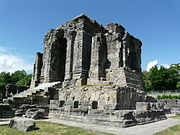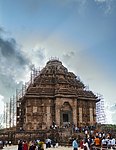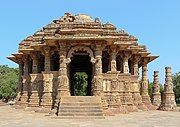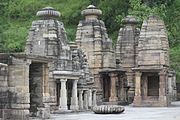Adityas

In Hinduism, Adityas (Sanskrit: आदित्य, romanized: Ādityá, lit. 'of Aditi', Sanskrit pronunciation: [aːdɪtjɐ]), refers to the offspring of Aditi, the goddess representing the infinity.[1] The name Aditya, in the singular, is taken to refer to the sun god Surya. Generally, Adityas are twelve in number and consists of Vivasvan (Surya), Aryaman, Tvashta, Savitr, Bhaga, Dhata, Mitra, Varuna, Amsa, Pushan, Indra and Vishnu (in the form of Vamana).[2]
They appear in the Rig Veda, where there are 6–8 in number, all male. The number increases to 12 in the Brahmanas. The Mahabharata and the Puranas mention the sage Kashyapa as their father.[2] In each month of the year a different Aditya is said to shine. According to the Vaishnava tradition of Hinduism, each of these Adityas is a different expression of the Supreme God Vishnu in the form of the Sun-God.[a]
Sun worship[]
Characterisation[]
The Aditya have been described in the Rig Veda as bright and pure as streams of water, free from all guile and falsehood, blameless, perfect.
This class of deities has been seen as upholding the movables and immovable Dharma. Adityas are beneficent gods who act as protectors of all beings, who are provident and guard the world of spirits and protect the world. In the form of Mitra-Varuna, the Adityas are true to the eternal Law and act as the exactors of debt.[5]
In present-day usage in Sanskrit, the term Aditya has been made singular in contrast to Vedic Adityas, and are being used synonymously with Surya, the Sun. The twelve Adityas are believed to represent the twelve months in the calendar and the twelve aspects of Sun. Since they are twelve in number, they are referred as DvadashAdityas.[6]
The 12 Ādityás are basically the monthly suns, corresponding to the approximately 12 lunations in a solar year.[c] These are also called the 12 purushas, pertaining to the 12 lunar months of the year. Here the months refer to the lunar months. In astronomy the lunar months with a solar sankranti are said to have an Aditya or purusha. The month without a sankranti is said to be neuter and is said to be an extra month or the intercalary lunar month.
Mentions in Hindu scriptures[]
The Ādityas are one of the principal deities of the Vedic classical Hinduism belonging to the solar class. In the Vedas, numerous hymns are dedicated to Mitra, Varuna, Savitr, etc.
In hymn 7.99 of the Rigveda, Indra-Vishnu produces the sun, his discus a vestige of his solar creation, equivalent to the sun. The Vishnu purana identifies the Discus chakra with the following: 'thoughts, like the chakra, flow faster than even the mightiest wind.'
The Gayatri mantra, which is regarded as one of the most sacred of the Vedic hymns is dedicated to Savitr, one of the principal Ādityas. The Adityas are a group of solar deities, from the Brahmana period numbering twelve. The ritual of Surya Namaskaar, performed by Hindus, is an elaborate set of hand gestures and body movements, designed to greet and revere the Sun.
The sun god in Hinduism is an ancient and revered deity. In later Hindu usage, all the Vedic Ādityas lost identity and metamorphosed into one composite deity, Surya, the Sun. The attributes of all other Ādityas merged into that of Surya and the names of all other Ādityas became synonymous with, or epithets of, Surya.
The Ramayana has Rama as a direct descendant of the Surya, thus belonging to the Suryavansha or the clan of the Sun. The Mahabharata describes one of its warrior heroes, Karna, as being the son of the Pandava mother Kunti and Surya.
The sun god is said to be married to the goddess Ranaadeh, also known as Sanjnya. She is depicted in dual form, being both sunlight and shadow, personified. The goddess is revered in Gujarat and Rajasthan.
The charioteer of Surya is Aruna, who is also personified as the redness that accompanies the sunlight in dawn and dusk. The sun god is driven by a seven-horsed Chariot depicting the seven days of the week and the seven colours of rainbow which are seen due to the dispersion by Surya's rays.
Surya Namaskar[]
Surya Namaskar, the Salute to the Sun or Sun Salutation, is worship of sun[7] which is also included as a practice in yoga as exercise incorporating a flow sequence of some twelve gracefully linked asanas.[8][9] Similar exercises were in use in India, for example among wrestlers. The basic sequence involves moving from a standing position into Downward and Upward Dog poses and then back to the standing position, but many variations are possible. The set of 12 asanas is dedicated to the solar deity Surya. In some Indian traditions, the positions are each associated with a different mantra.
Sun worship festivals[]
Makar Sankranti is a festival dedicated to sun worship in India and by the hindu diaspora of India.
Chhath (Hindi: छठ, also called Dala Chhath) is an ancient Hindu festival dedicated to Surya, the chief solar deity, unique to Bihar, Jharkhand and the Terai. This major festival is also celebrated in the northeast region of India, Madhya Pradesh, Uttar Pradesh, and parts of Chhattisgarh. Hymns to the Sun can be found in the Vedas, the oldest sacred texts of Hinduism. Practiced in different parts of India, the worship of the Sun has been described in the Rigveda. There is another festival called Sambha-Dasami, which is celebrated in the state of Odisha for the surya.
The sun is prayed to by South Indians during the harvest festival.[10] In Tamil Nadu, the Tamil people worship the sun god during the Tamil month of Thai, after a year of crop farming. The month is known as the harvesting month and people pay respects to the sun on the first day of the Thai month known as Thai pongal, or Pongal, which is a four-day celebration.[11] It is one of the few indigenous worship by the Tamil people irrespective of religion.[12]
Names of solar deities[]
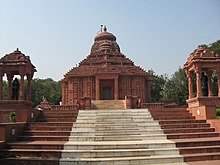
Rigveda[]
In the Rigveda, the Adityas are seven or eight in number and include:[2]
Brahmanas[]
List of adityas[]
In the Satapatha Brahmana, the number of Adityas is eight in some passages, and in other texts of the same Brahmana, twelve Adityas are mentioned.[15]:102 The list of 12 Adityas is as follows:
Upanishads[]
In the Chandogya Upanishad, Aditya is a name of Viṣṇu in his avatar as Vāmana. His mother is Aditi.
Vishnu Purana[]
The Adityas in the Vishnu Purana[16] are:
Bhagavata Purana[]
List of adityas[]
In the Bhagavata Purana, the names of 12 Adityas are given as:
Each aditya's respective functions[]
In each month of the year, it is a different Aditya who shines as the Sun-God (Surya).[17]
| Name | Action | |
| 1 | As Indra or Vishnu |
he destroys the enemies of the gods |
| 2 | As Dhata | he creates living beings |
| 3 | As Parjanya | he showers down rain |
| 4 | As Tvashta | he lives in the trees and herbs |
| 5 | As Pusha | he makes foodgrains grow |
| 6 | As Aryama | he is in the wind |
| 7 | As Bhaga | he is in the body of all living beings |
| 8 | As Vivasvana | he is in fire and helps to cook food |
| 9 | As Amshumana | he is again in the wind |
| 10 | As Varuna | he is in the waters and |
| 11 | As Mitra | he is in the moon and in the oceans |
Linga Purana[]
According to the Linga Purana,[18] the Adityas are:
- Brahma
- Vishnu
- Indra (The head of Adityas)
- Tvaṣṭṛ
- Varuṇa
- Dhata
- Bhaga
- Savitṛ
- Vivasvat
- Amshuman
- Mitra
- Pūṣan
Aditya as nakshatra devatas[]
This section does not cite any sources. (May 2020) |
Adityas are responsible for proper functioning of the universe and in Hindu cosmology they are given lordship over celestial constellations, called nakshatras in Jyotish. Nakshatras are forces of universal intelligence which are intertwined with the birth-death cycle of life, identity of all created beings, events and day to day consciousness in our lives. In India, at Konark, in the state of Odisha, a temple is dedicated to Surya. The Konark Sun Temple has been declared a UNESCO World Heritage Site. Surya is the most prominent of the navagrahas or nine celestial objects of the Hindus. Navagrahas can be found in almost all Hindu temples.
Adityas manage the Shakti of the nakshatras. Here are few examples.
- Bhaga has lordship over Purva Phalguni nakshatra. Bhaga is bestower of fortune. Bhaga in Sanskrit means "a portion" so our portion in life is regulated by this divine celestial being. Many a times this is related to fortunate marriages, or fortune from marriage and partnerships. It is a very worldly nakshatra bestowing divine intelligence with respect to worldly gains in life. Beings born when Purva Phalguni is rising in the east are literal physical manifestation of this energy.
- Aryama, the God of Patronage, is an Aditya who is the lord of Uttar Phalguni nakshtra and as suggested by the name, a person born under the auspices of Aryama finds many lucky opportunities with benefactors in their lives, among many other qualities that are possessed by this divine being.
- Savitur, rules over Hasta Nakshatra and is the cheerful Aditya who manages worldly skills and artistry. Handiwork of all kinds, from needlework, pottery making to technical skills industry, sleight of hand pick pockets, magicians, and Reiki masters all are blessed by the divine intelligence and benevolence of this Aditya.
- Mitra, rules over Anuradha nakshtra they are the peacekeepers of this world.
- Varuna, rules over Shatbhishak nakshatra the nakshatra of 1000 healers and gives a person intelligence about all sorts of medicine. Varuna as its ruling Aditya is lord keeper of law, hence themes of crime and punishment, law and order fall under his rulership. Varuna in RigVeda is to be feared and not taken lightly.
This makes Vedic Adityas not some conceptual, abstract, or mythological characters in a story book, but part of the visible cosmology and the everyday realities of our daily lives. We manifest their qualities in our lives and as such are part of the divine ourselves.
List of sun temples[]
| |||||
The sun temples of the Indian subcontinent are dedicated to the Hindu deity Surya,[19] with the most prominent among them being the Konark Sun Temple (also known as the Black Pagoda) -a UNESCO World Heritage Site.[20][21] at Konark in Odisha and the Sun Temple at Modhera, Gujarat, built in 1026–1027. Both are now ruins, having been destroyed by invading muslim armies. Konark was constructed around 1250, by Narasimhadeva I of the Eastern Ganga Dynasty.[22][23] Surya was an important deity in early Hinduism, but sun worship largely declined as a principal deity around the 12th century. In Manipuri mythology, the sun god Korouhanba is the synonym of the Hindu deity Surya. Other Surya or sun temples in the Indian subcontinent include:
- Andhra Pradesh
- Surya Narayana Temple at Arasavalli in Andhra Pradesh built in 7th century by king Devendra Varma, ruler of Kalinga[24][25] The temple is constructed in such a way that on the day of Radhasaptami, the Sun's rays directly fall on the feet of the Sri Suryanarayana Swami, the deity at the temple.
- Assam
- Surya Pahar Temple at Sri Surya Pahar in Assam built in 9th century[24]
- Bihar
- Deo Surya Mandir in Deo, Bihar
- Bhaskar Temple at Gaya in Bihar[24]
- Bhaskar Temple at in Bihar
- Bhaskar Temple at Patna in Bihar
- Bhaskar Temple at
- Bhaskar Temple at
- Bhaskar Chhth ghat, Selhauri in
- Manjesh Bhaskar Temple at
- Budha Bhaskar temple at
- Bhushan Bhaskar temple at Chain Singh Patti
- Bhagwan Bhaskar Dham at in Arrah
- Surya Temple at
- Sun Temple at Nalanda
- Sun Temple at Baragaon
- Sun Temple at
- Sun Temple at Muzaffarpur
- Sun Temple at Beraunti
- Sun Temple at
- Sun Temple at
- Sun Temple at
- Sun Temple at
- Sun Temple at Ben
- Sun Temple at
- Sun Temple at
- Sun Temple at
- Sun Temple at
- Sun Temple at Lal Bigha, Nawada
- Sun Temple at
- Sun Temple at Bilari
- Gujarat
- Haryana
- Within 48 Kos Parikrama of Kurukshetra
- Within Borshyam Surya tirtha
- Within Aaugandh Suryakunda
- Within Habri Suryakunda
- Within Sajuma Suryakunda
- Surajkund, Faridabad
- Within 48 Kos Parikrama of Kurukshetra
- Jammu and Kashmir
- Martand Sun Temple, near Anantnag in Jammu and Kashmir built in 10th century[28]
- Karnataka
- Soorya Narayana Temple at Maroli, Mangalore, Karnataka
- Kerala
- Adithyapuram Sun Temple
- Madhya Pradesh
- Bhramanya Dev Temple at Unao, Balaji in Madhya Pradesh[24]
- Birla Sun Temple in Gwalior
- Sun Temple:- Madkhera is a small village situated on the North-West of Tikamgarh town at a distance of about 20 km. The entrance of the Sun temple is from the east and the Sun idol is placed inside.[29]
- Manipur
- Ebudhou Korouhanba Temple, Moidangpok, Patsoi, Manipur
- Odisha
- Biranchinarayan Temple, Palia, a 13th-century temple in Palia, Odisha.[30]
- Tamil Nadu
- Suryanar Kovil Temple at Kumbakonam in Tamil Nadu built in 1060-1118 CE[24]
- Uttarakhand
- Sun temple at Katharmal, near Almora and 70 km from Nainital was built in 9th century CE by the Katyuri kings.** Sun temple at Katharmal, near Almora and 70 km from Nainital was built in 9th century CE by the Katyuri kings.[31][32][33][34]
- Uttar Pradesh
- Sun Temple at Kalpi in Uttar Pradesh
- Pakistan
See also[]
- Sun worship in Hinduism
- Aditi
- List of solar deities in Hinduism
- List of Surya temples
- Surya Namaskar
- Other related
- Ashvins
- Prajapati
- Rudras
- Vasus
- List of Hindu deities
- List of Hindu temples
- List of Hindu pilgrimage sites
Further reading[]
- "On the Ādityas". hinduwebsite.com. Concepts in Hinduism.
Notes[]
- ^ In Vaishnava beliefs, Adityas are the opulent expansions of the god Vishnu, in the form of the sun-god. These deities take away all the sinful reactions of those who remember them each day at dawn and sunset.[3]
- ^ Incorporating Ashtanga Namaskara in place of Caturanga Dandasana
- ^ The actual value is close to 12+7/19; 7/19 ≈ 1⁄3 ; so there always 12 complete lunar months in a solar year, and about every third year there is an extra, 13 th lunar month, which the assignment of deities to months does not appear to address.
References[]
- ^ Werner, Karel (2005). A Popular Dictionary of Hinduism. Routledge. p. 17. ISBN 9781135797539.
- ^ Jump up to: a b c Dalal, Roshen (2014-04-18). Hinduism: An alphabetical guide. Penguin UK. ISBN 978-81-8475-277-9.
- ^ Srimad Bhagavata Purana. 12.11.45.
- ^ "Destination Delhi". Indian Express. 4 September 2010.
- ^ Rig Veda. Translated by Griffith, Ralph T.H. Book 2, Hymn XXVII.
- ^ Sathyamayananda, Swami. Ancient Sages. Mylapore, Chennai: Sri Ramakrishna Math. p. 173. ISBN 81-7505-356-9.
- ^ Singh, Kritika. Sun Salutation: Full step by step explanation. Surya Namaskar Organization.
- ^ Mitchell, Carol (2003). Yoga on the Ball. Inner Traditions. p. 48. ISBN 978-0-89281-999-7.
- ^ MacMullen, Jane (1988). "Ashtanga Yoga". Yoga Journal. September/October: 68–70.
- ^ Jain Chanchreek; K.L. Chanchreek; M.K. Jain (2007). Encyclopaedia of Great Festivals. Shree Publishers. pp. 36–38. ISBN 978-81-8329-191-0.
- ^ "502 Bad Gateway nginx openresty 208.80.154.49". www.pongal-festival.com.
- ^ "Tamizhs festival". ntyo.org. Archived from the original on 27 December 2001. Retrieved 3 July 2019.
- ^ Jamison, Stephanie; Brereton, Joel (2015). The Rigveda – Earliest religious poetry of India. Oxford University Press. p. 43. ISBN 978-0190633394.
- ^ MacDonell, Arthur Anthony (1897). Vedic Mythology. Oxford University Press. p. 43.
- ^ Muir, John (1863). Original Sanskrit Texts on the Origin and Progress of the Religion and Institutions of India. Williams and Norgate.
- ^ "Book I: Chapter XV". Vishnu Purana – via Sacred-Texts.com.
- ^ Srimad Bhagavata Purana. 12.11.27–49.
- ^ Linga Purana.
- ^ A. Bhatnagar; William Livingston; W. C. Livingston (2005). Fundamentals of Solar Astronomy. World Scientific Publishing. p. 28. ISBN 9789812567871.
- ^ Robert Ebersole (1957). Black Pagoda. University of Florida Press. p. 7. Retrieved 13 January 2014.
- ^ "Official website". Tourism Department, Government of Odisha. Retrieved 9 January 2014.
- ^ Robert Ebersole (1957). Black Pagoda. University of Florida Press. p. 34. Retrieved 13 January 2014.
- ^ "Fall of Konark". Tourism Department, Government of Odisha. Archived from the original on 19 June 2009. Retrieved 13 January 2014.
- ^ Jump up to: a b c d e "A visit to the Sun Temple". The Hindu. 28 February 2009. Archived from the original on 9 January 2014. Retrieved 9 January 2014.
- ^ "Sun rays touch Arasavalli deity". The Hindu. 10 March 2011. Retrieved 9 January 2013.
- ^ "Modhera sun temple". Gujarat Tourism. Archived from the original on 28 September 2011. Retrieved 9 January 2014.
- ^ Archaeology in India. Archaeological Survey of India. 1950. p. 101.
- ^ "District Anantnag". Anantnag District Administration. Archived from the original on 22 December 2013. Retrieved 9 January 2014.
- ^ यह है मरखेड़ा का सूर्य मंदिर,पुरातत्व विभाग की अनदेखी से प्रतिमाएं हो रहीं दुर्दशा का शिकार, Dainik Bhaskar, accessed 30 aug 2021.
- ^ "A Little Known Sun Temple At Palia" (PDF). Government of Odisha. April 2006. Retrieved 9 January 2014.
- ^ Sajwan, Venita (17 August 2002). "A lesser-known sun temple at Katarmal". The Tribune. Retrieved 8 July 2013.
- ^ "Katarmal Sun temple, Almora". Nainital Tourism. Retrieved 9 July 2013.
- ^ "Sun Temple at Katarmal". Huntington Archive. Ohio State University. Archived from the original on 23 January 2014. Retrieved 23 January 2014.
- ^ Venita Sajwan (17 August 2002). "A lesser-known sun temple at Katarmal". The Tribune, online edition. Retrieved 23 January 2014.
- ^ Journal of Indian history: golden jubilee volume. T. K. Ravindran, University of Kerala. Dept. of History. 1973. p. 362.
- ^ A glossary of the tribes and castes of the Punjab and North-West ..., Volume 1 By H.A. Rose. 1997. p. 489. ISBN 9788185297682.
External links[]
 Media related to Adityas at Wikimedia Commons
Media related to Adityas at Wikimedia Commons
- Hindu deities
- Hindu temples
- Hindu pilgrimage sites
- Adityas
- Solar gods
- Rigvedic deities

